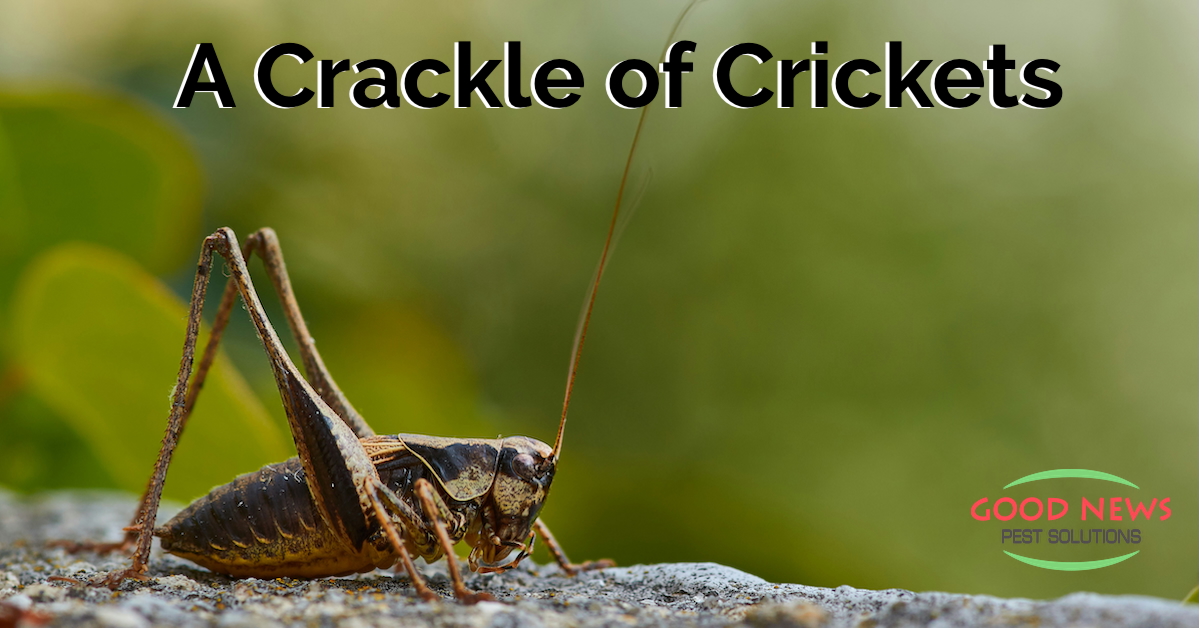
A Crackle of Crickets
Welcome to November! We set the clocks back, so now it gets darker sooner, and right away the temperatures have dropped! Okay, just down to the low 80s. But it was in the 90s last month, and by the time we get to Thanksgiving, we’ll be in the mid to upper 70s, pretty much as cool as it gets here on the Gulf Coast of Florida.
As anyone who’s been here more than a year knows, that feels cooler to us than it would to the folks in the Midwest where it’s edging into the 40s and 50s or cooler. And just like us, many of the insects in Florida notice the cool weather too.
As you may have guessed from the image for this article, one of those insects is the cricket. As we creep into November and December, two troublesome species of chirpers will try to infiltrate your home. Here’s what to look out for.
Call it a Cacophony
If you’ve ever woken up in the middle of the night hearing a steady “chuurp! chuurp!” you know how annoying a cricket in your home can become. And it’s rarely only one. How do we know? Because that distinctive sound is the male cricket trying to get a female’s attention.
Male crickets rub the sharp-edged scraper at the base of one front wing along a file-like ridge on the bottom edge of the other front wing to make the chirping sound. And they don’t stop until they get what they want. One cricket was recorded chirping a record 2,640 times without stopping!
Crickets tend to chirp faster in warm weather and slower in chillier temperatures. When it’s warm, their wings often move faster than the human eye can see.
Biologist Laurel Symes of Dartmouth College spent years recording the cricket song and slowing it down. She discovered not only do the 900 different species of crickets have slightly different chirps, but also a great variety in pulse and rhythm, even though we can’t hear it with the naked ear. She even determined that if you count the number of chirps of the snowy cricket in 13 seconds, then add 40, you’ll get the exact temperature in Fahrenheit. Hence their nickname: thermometer crickets.
It gets even weirder – crickets also hear with their legs. The insects feel vibrations through their tympanum, a special auditory organ that keeps them safe from predators and makes them nearly impossible to sneak up on!
These insects are named for their sound: the term cricket comes from the Old French word criquet. Thanks to their distinctive sonic profile, groups of crickets have acquired some harmonious names – an orchestra or a symphony of crickets. But our favorite has got to be a crackle of crickets.
Not Always LIKE JIMINY
Other than the sometimes annoying sound late at night (crickets are nocturnal), crickets can be a real problem in your home. Typically, crickets live outdoors in piles of debris, rocks, firewood, and lumber. They’re largely omnivorous, feeding on decaying leaves, plants, and other insects. But inside your house, they will eat anything including clothes, carpet, even wood and furniture. They’re particularly fond of your delicate wools and silks and fermented beverages such as beer or sweetened vinegar. Nobody mentions that when they praise Jiminy Cricket!
Disney likely chose the blue top hat sporting voice of morality for Pinocchio due to crickets’ history as a good luck charm in many Asian countries. There is a cricket in the original serialized Italian story by Carlo Collodi, but the puppet that comes to life quickly squashes the bug when it tries to give him advice. But in China, from 220 BC to nearly 1900, crickets were a popular pet for nobles, kept in golden cages. Even the less royal folks got into it, but their cages were usually bamboo. They even used to have cricket fighting championships.
Contrast that now to the most popular use for crickets in Asia – as a food source. Crickets are an excellent source of protein, fat, vitamins, minerals, and fiber and recent research suggests eating crickets may improve your gut health. They’re also a more environmentally friendly protein, easier to raise, and requiring less water and resources, while emitting a fraction of greenhouse gasses compared to American livestock.
And if you can get past the creepy factor, crickets actually have a better flavor and texture than tofu and many other fake or substitute meat alternatives.
Other Oddities
So far, we’ve mostly been talking about house crickets. After all, they’re the ones we see most often in the Sunshine State and the ones that cause the most damage. But crickets don’t stop there – remember the 900 species? The red-headed bush cricket, as you might expect, has a bright red front on their bodies and a black backside. They have a high-pitched, shockingly loud song.
The snowy-tree cricket is bright pastel green with large wings that resemble tennis rackets. Nisitrus species crickets have an intricate Argyle-sweater style pattern on their backsides. And here in Florida, we also have to deal with mole crickets. Scapteriscus borellia Giglio-Tos look rather different from what we think of as crickets, with enlarged, shovel-like front legs for digging. They burrow and live underground and destroy the roots of plants. If you have dead patches of grass in your otherwise healthy lawn, you’ve probably got mole crickets.
If you see signs of house crickets in your home, we are happy to help. Our highly-trained technicians come equipped with solutions for removing the annoying insects from your house, and then recommend sealing up any entry points so they can’t get back in as part of our Go Green Perimeter Plus service. It also helps with roaches, ants, and spiders. For more information, or to schedule an appointment, please give us a call!
« Back to BlogProudly Serving
Sun City Center, Ruskin, Palmetto, Parrish, Ellenton, Bradenton, Anna Maria, Holmes Beach, Bradenton Beach, Longboat Key, Lakewood Ranch, University Park, Myakka City, Sarasota, Siesta Key, Osprey, Nokomis, Casey Key, Venice, Englewood, North Port, Port Charlotte, Punta Gorda, Arcadia
Things You Can Do
Pay Your Bill Online
Leave Us a Review
Request a Free* Termite Inspection
Stop Mosquito Bites
Get Rid of Rodents
Get a Termite Damage Warranty
Get Pest Control for Your Attic
Get Pest Control for Your Business Request Prayer
Corporate Address
1080 Enterprise Court, Ste A
North Venice, FL 34275
Call Now: (941) 412-9610
Text: (941) 412-9610
Fax: (941) 412-0080
